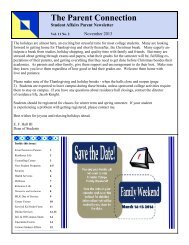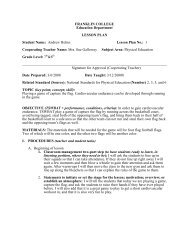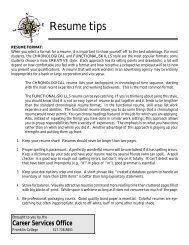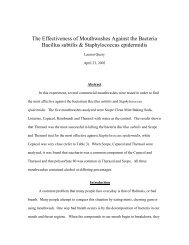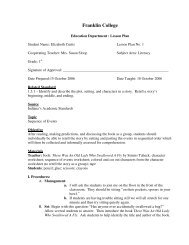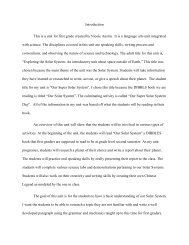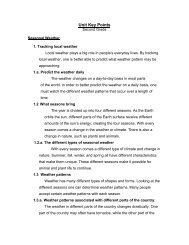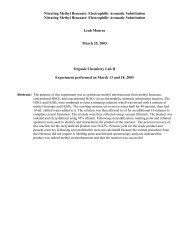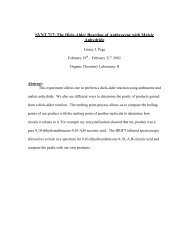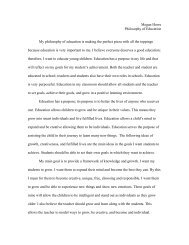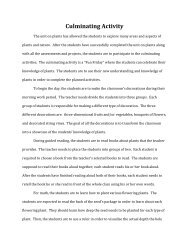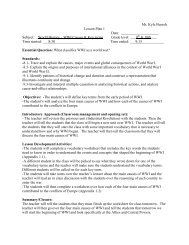Keurig: Managing a New Product Launch By ... - Franklin College
Keurig: Managing a New Product Launch By ... - Franklin College
Keurig: Managing a New Product Launch By ... - Franklin College
You also want an ePaper? Increase the reach of your titles
YUMPU automatically turns print PDFs into web optimized ePapers that Google loves.
<strong>Keurig</strong>: <strong>Managing</strong> a <strong>New</strong> <strong>Product</strong> <strong>Launch</strong><br />
<strong>By</strong>: Melissa Bockhold<br />
Heather Coddington<br />
Laura Duerstock<br />
Ali Wampler<br />
March 1, 2006
TABLE OF CONTENTS<br />
I. Introduction……………………………………………………………………3<br />
II. Assumptions…………………………………………………………………...4<br />
III. History………………………………………………………………………....5<br />
IV. SWOT Analysis<br />
1. Two-Cup Approach……………………………………………………….6<br />
2. One-Cup Approach………………………………………………………..7<br />
V. The Coffee Market<br />
1. Market Analysis/Needs/Growth…………………………………………...8<br />
2. Competition………………………………………………………………..9<br />
VI. <strong>Keurig</strong> Marketing Strategy<br />
1. Target Market…………………………………………………………….11<br />
2. <strong>Product</strong><br />
i. K-Cups (or <strong>Keurig</strong> Cups)...…………………………………….14<br />
ii. B100 Brewer...…………………………………………………15<br />
iii.<br />
3. Place<br />
<strong>Product</strong> Life Cycle……………………………………………..16<br />
i. K-Cups (or <strong>Keurig</strong> Cups)...…………………………………….16<br />
ii. B100 Brewer...…………………………………………………17<br />
iii. Market Segmentation…………………………………………..18<br />
4. Promotion<br />
i. K-Cups (or <strong>Keurig</strong> Cups)...…………………………………….19<br />
ii.<br />
5. Pricing<br />
B100 Brewer...…………………………………………………19<br />
i. K-Cup (or <strong>Keurig</strong>-Cup)……..………………………………….21<br />
ii. B100 Brewer...….……………………………………………...26<br />
VII. Problematic Issues and Alternatives…………………………………………36<br />
VIII. Conclusion…………………………………………………………………...38<br />
IX. Comments on Opposing Group’s Paper……………………………………..39<br />
X. <strong>Keurig</strong> Authorized Dealer Interview………………………………………...44<br />
XI. Works Cited………………………………………………………………….46<br />
2
I. INTRODUCTION<br />
Everyone has a morning ritual while getting ready for the day’s activities. Some<br />
people exercise. Some people shower. Some people help get their children ready for<br />
school. Some people watch the news or listen to traffic reports. Some people drink<br />
coffee. In fact, in 2001, 20 million Americans drank gourmet coffee on a daily basis<br />
(Sherry).<br />
<strong>Keurig</strong>, Inc. was founded on the idea that coffee lovers should be able to brew and<br />
enjoy one perfect cup of coffee at time. With the establishment of gourmet coffee houses<br />
like Starbucks, consumers began stretching their pocketbooks a bit more by spending on<br />
average $1.50 or more for a cup of gourmet coffee (Anderson 4). This change in<br />
consumer behavior opened the door for <strong>Keurig</strong> to offer gourmet coffees by the single-cup<br />
in offices in 1998. <strong>Keurig</strong> noticed that from 1996 to 2000 gourmet coffee sales increased<br />
by 40 percent in the U.S. at-home coffee market. This statistic persuaded <strong>Keurig</strong>’s<br />
management to develop an at-home, one-cup coffee brewer specifically for gourmet<br />
coffee lovers (Anderson 15).<br />
<strong>Keurig</strong>’s development progress toward the launch of their first at-home brewing<br />
model was stunted in February of 2003, six months prior to the release date of the brewer,<br />
by company shareholder Green Mountain Coffee Roasters Inc. This paper will address<br />
Green Mountain Coffee Roasters’ concerns and provide recommendations and alternative<br />
solutions to problematic pricing and marketing dilemmas. In addition to our analysis, we<br />
are going to examine the presenters’ approach and critique the options they suggest.<br />
3
II. Assumptions<br />
In analyzing the marketing strategies and launch options of <strong>Keurig</strong>, Inc., we are operating<br />
under the following assumptions:<br />
• Surveys and market testing were completed with professional services and<br />
accurately reflect the current feelings of the consumers at the time of testing.<br />
• The description of the coffee drinkers/customers is correct.<br />
• <strong>Keurig</strong> is outsourcing the manufacturing of their brewers.<br />
• <strong>Keurig</strong> has already incurred design and manufacturing cost of their <strong>Keurig</strong>-Cup<br />
and brewer of $700,000 ($400,000 for development of the new cup-based<br />
technology, and $60,000 per <strong>Keurig</strong>-Cup packaging line, assuming one line per<br />
each of <strong>Keurig</strong>’s five roasters).<br />
• The manufacturer of the B100 included all variable and fixed costs in their<br />
calculation of the unit costs for manufacturing the B100 brewer.<br />
• The costs of the B100 brewer, as reported by the manufacturer, are $220 at the<br />
time of Mr. Lazaris’ meeting with GMCR management. The manufacturer is<br />
attempting to lower those costs to $200, but this has not yet been achieved.<br />
4
III. History<br />
Timeline of <strong>Keurig</strong>, Inc. and the North American Coffee Market<br />
Mid-<br />
1940s<br />
1960s<br />
Mid-<br />
1990s<br />
• Peak of coffee consumption (16.5 pounds per capita)<br />
• Popularity of soft drinks causes coffee consumption to decline<br />
• All-time low of coffee consumption (6.1 pounds per capita)<br />
1992 • <strong>Keurig</strong>’s inception<br />
Late<br />
1990s<br />
1998<br />
2000<br />
2001<br />
2002<br />
2003<br />
• Gourmet coffeehouses reinvigorate the market<br />
• <strong>Keurig</strong> introduces its single-cup brewing system (B2000 model); 8 varieties of coffee<br />
offered<br />
• 14.8% of brewer distributors offer a single-cup system for the Office Coffee Service<br />
(OCS) market<br />
• 44.8% of brewer distributors offer a single-cup system for the OCS market<br />
• Filterfresh establishes relationship to market <strong>Keurig</strong>’s commercial brewer, thus creating a<br />
system with greater variety of coffees and teas<br />
• (February) Ownership structure changes; three largest shareholders become Van Houtte,<br />
Inc. (28%), Green Mountain Coffee Roasters, Inc. (42%), and Memorial Drive Trust<br />
• John Whoriskey joins <strong>Keurig</strong> as the GM of the at-home Division<br />
• <strong>Keurig</strong>’s roaster partners ship more than 125 million K-Cups<br />
• Total K-Cup shipment since the launch rises over 340 million<br />
• <strong>Keurig</strong> begins working on a line of teas (T-Cups); the first line is to be “Celestial<br />
Seasonings” brand teas<br />
• OCS market reaches $3.46 billion in total revenue<br />
• <strong>Keurig</strong>’s total number of brewers shipped across North America reaches 33,000<br />
• 20 million Americans are drinking gourmet coffee on a daily basis<br />
• (February) <strong>Keurig</strong> sets plans to launch B100 system in the at-home market<br />
• Total single-cup brewer placement in the OCS market reaches 143,200<br />
• <strong>Keurig</strong> increases roaster partnership to five, thus providing the largest variety of coffees<br />
for a single-cup brewing system<br />
5
IV. SWOT<br />
1. Two-Cup Approach with Brewer<br />
Strengths<br />
• Does not threaten the KADs and the OCS market<br />
• Increases control of pricing – specifically for the <strong>Keurig</strong>-Cup<br />
• Increases the likelihood of managers’ participation in in-office promotions of the<br />
Weaknesses<br />
<strong>Keurig</strong> at-home system, because the differentiation would prevent theft of K-Cups<br />
provided for office consumption.<br />
• Don’t confuse the buyer. Similarity between cups can cause confusion between<br />
which cup goes with which brewer.<br />
• Increased inventory for roasters<br />
• Lack of demonstration ability in retail sector – <strong>Keurig</strong>-Cups not available for<br />
purchase in retail stores<br />
• Lack of resources to properly market and sell brewer and <strong>Keurig</strong> cup in retail<br />
outlets<br />
Opportunities<br />
• No change or continued growth in OCS market = more available resources for<br />
Threats<br />
expanding distribution of at-home market into the retail sector<br />
• Brewer pricing does not decrease and competition enters with a lower pricing<br />
strategy; <strong>Keurig</strong> suffers large losses.<br />
6
• The brewer pricing is so high that breakeven sale point is not met, making <strong>Keurig</strong><br />
rely on <strong>Keurig</strong>-Cup sales to make up for losses from brewer sales. This scenario<br />
results in the brewer becoming loss leader.<br />
• Possibility of threatening the OCS market, which is <strong>Keurig</strong>’s cash cow<br />
2. One-cup Approach with Brewer<br />
Strengths<br />
• Allows quick entry into the at-home market before competition<br />
• Less customer confusion<br />
• Roasters not required to keep two separate cup inventories (one inventory for<br />
OCS market and one for at-home market)<br />
• Roasters’ production levels will probably increase with the increase in demand,<br />
Weaknesses<br />
since the at-home market will include KADs and at-home consumers.<br />
• Could result in alienation of the OCS K-Cup channel<br />
• Decrease in control of pricing with the KADs<br />
Opportunities<br />
• If <strong>Keurig</strong> is able to enter the market quickly, then they have more opportunity and<br />
time to come out with smaller and cheaper brewers.<br />
• Easier to enter the retail market in the future because of less overall costs<br />
Threats<br />
• Brewer pricing does not decrease and competition enters with a lower pricing<br />
strategy; <strong>Keurig</strong> suffers loss of market share.<br />
• Lack of resources to market and sell brewers and cups through retail outlets at<br />
time of launch<br />
7
• OCS users experience losses from K-Cup theft and thus it is not economical for<br />
offices to use the <strong>Keurig</strong> system.<br />
V. The Market<br />
As shown in our diagram below, the overall coffee market is vast and growing.<br />
The gourmet coffee market generates around $7 billion dollars in sales annually.<br />
According to these statistics, there is a market, in terms of amount of coffee consumed,<br />
for <strong>Keurig</strong>’s single-cup brewer. However, <strong>Keurig</strong> is not the only company with their eye<br />
on the single-cup market. Several others are seeing the growth potential and are<br />
developing their own at-home one-cup brewers. This section will delve more into the<br />
coffee market as a whole and the competition that is challenging <strong>Keurig</strong>.<br />
1. Market Analysis/Needs/Growth<br />
2000 Total Retail Coffee Market ($ in billions)<br />
Ot her,<br />
4.6 billion<br />
A way f rom Home - Gourmet , 3.9<br />
billion<br />
A t Home - Gourmet ,<br />
3.1 billion<br />
At Home - Retail,<br />
6.9 billion<br />
(Anderson 6)<br />
8
2. Competition<br />
In the Away-from-Home single-cup market, <strong>Keurig</strong> has two primary competitors:<br />
Filterfresh Coffee Service, Inc. and Flavia. Filterfresh, subsidiary of Van Houtte, Inc.,<br />
was the pioneer of the one-cup coffee brewing system, introducing the technology in the<br />
1980s. Although Filterfresh was the first to introduce a single-cup brewer, their system<br />
left much room for improvement. The hopper it used made clean-up and reloading coffee<br />
beans necessary (Anderson 5). <strong>Keurig</strong>’s introduction of the K-Cup enhanced the one-cup<br />
system to something better and more convenient for users. Similar to <strong>Keurig</strong>’s system,<br />
Flavia’s focus is also on ease of use. Flavia offers a variety of twenty-four coffees in<br />
individual, foil-sealed Filterpacks (Anderson 6).<br />
In the at-home single-cup market, <strong>Keurig</strong> faces greater competition. Both Salton<br />
and Sara Lee plan to enter the at-home market, and there is speculation that both Procter<br />
& Gamble and Nestlé may do so as well. The pricing of Procter & Gamble, Nestlé, and<br />
other competitors’ brewers and coffee pods is much lower than the proposed pricing of<br />
<strong>Keurig</strong>’s. They also plan to sell through mass retail and grocery outlets (Anderson 8-9).<br />
Salton’s home model retails at $49, Sara Lee’s at $70, and Procter & Gamble is expected<br />
to price similarly upon entering the market (Anderson 8). <strong>Keurig</strong> does not currently have<br />
the resources to compete in these retail markets, so one of <strong>Keurig</strong>’s challenges is in<br />
creating meaningful product differentiation to bring their brewer to the up-scale market.<br />
9
In looking at the following exhibit, we can see that there is stiff competition in the<br />
general coffee market:<br />
Chock Full o' Nuts<br />
3%<br />
Private Label<br />
8%<br />
Community Coffee<br />
2%<br />
Tetley<br />
2%<br />
Starbucks<br />
4%<br />
Nestle<br />
5%<br />
2000 Coffee Market Share<br />
Other<br />
8%<br />
Philip Morris/Kraft<br />
32%<br />
Proctor & Gamble<br />
36%<br />
(Anderson 18)<br />
Together, Procter & Gamble and Philip Morris/Kraft hold 68% of the entire<br />
market, although they primarily target the non-gourmet coffee consumer (Anderson 18).<br />
<strong>Keurig</strong> must utilize a marketing strategy that creates a competitive advantage, thus taking<br />
away market share from other companies and attracting those customers to gourmet<br />
coffee and brewing systems.<br />
While the entire coffee market seems to be an oligopoly with Procter & Gamble<br />
and Philip Morris/Kraft as the main competitors, <strong>Keurig</strong> is targeting a more up-scale<br />
audience of gourmet coffee drinkers. Here, it is important to define the relevant target<br />
market and competitors within that market. In the gourmet sector of the coffee market,<br />
perfect competition does not exist; not all products offered are exactly the same. Instead,<br />
10
this is monopolistic competition. <strong>Product</strong>s and whole marketing mixes contain<br />
differences between companies, models, and pod systems. This gives the competitors<br />
pricing options (McCarthy 96).<br />
In this monopolistic competition, <strong>Keurig</strong>’s K-Cup (or <strong>Keurig</strong>-Cup) system and<br />
brewer match up very well against the competition. <strong>Keurig</strong> has some significant<br />
advantages over the competition; there are, however, areas in which <strong>Keurig</strong> trails. For<br />
example, when comparing the brewers of Flavia and Melitta, a subsidiary of Salton, the<br />
main difference is in the size of cup brewed. Melitta and Flavia both offer the user a<br />
choice between a strong five-ounce cup and a weaker eight-ounce cup. <strong>Keurig</strong>’s B100<br />
only offers the eight-ounce choice (Davids). However, <strong>Keurig</strong> is viewed to have the<br />
upper hand over these two companies because they offer the consumers a greater variety<br />
of coffees and a better quality coffee with every cup.<br />
In the up-scale sector of multi-cup brewers, competition includes Cuisinart,<br />
Krups, Braun, DeLonghi, and Bunn (Anderson 8). The consumers of these up-scale<br />
brewers are those that <strong>Keurig</strong> will target and attempt to show the appeal of one-cup<br />
technology.<br />
VI. <strong>Keurig</strong> Marketing Strategy<br />
All companies need a marketing strategy upon entering a new market. In<br />
<strong>Keurig</strong>’s case, they had a successful marketing strategy for the OCS market already in<br />
place by the time they decided to break into the at-home market. Below, we will discuss<br />
<strong>Keurig</strong>’s approach to marketing their B100 brewer.<br />
1. Target Market<br />
As <strong>Keurig</strong> decided whether or not to launch their product into the at-home market,<br />
they looked at the statistics for the United States retail at-home coffee market. The<br />
11
esults were very promising. In 1996, gourmet coffee sales were at $2,200 million. Four<br />
years later, in 2000, the gourmet coffee sales had increased by 40 percent to $3,100<br />
million. Also, in 2000, approximately 320 million pounds of gourmet coffee were sold in<br />
the United States, a 25.5 percent increase in pound consumption by volume from 1996.<br />
These large boosts in the market’s gourmet coffee area proved to <strong>Keurig</strong> that this market<br />
was and would continue to quickly expand. <strong>Keurig</strong> needed to find out if their single-cup<br />
brewer would be accepted by gourmet coffee consumers (Anderson 15).<br />
Year<br />
2000<br />
1999<br />
1998<br />
1997<br />
1996<br />
U.S. Retail At-Home Coffee Market<br />
2200<br />
0 500 1000 1500 2000 2500 3000 3500 4000 4500<br />
2500<br />
Coffee Sales ($ in millions)<br />
2800<br />
3000<br />
3100<br />
3815<br />
3800<br />
3975<br />
3905<br />
4205<br />
Gourmet<br />
Mass Market<br />
12
Year<br />
2000<br />
1999<br />
1998<br />
1997<br />
1996<br />
255<br />
270<br />
290<br />
U.S. Retail At-Home Coffee Market<br />
320<br />
310<br />
0 100 200 300 400 500 600 700 800 900<br />
Pound Volume (in millions)<br />
840<br />
830<br />
850<br />
845<br />
850<br />
Gourmet<br />
Mass Market<br />
From 1999 to 2001, <strong>Keurig</strong> carried out market research studies to determine the<br />
acceptability of their product to the at-home consumer. The research was conducted in<br />
several different formats. There were intercept and internet surveys, surveys of current<br />
OCS users, and focus groups of at-home test users (Anderson 7).<br />
The results of the intercept surveys, whose respondents had to drink at least one<br />
cup of gourmet coffee per day, showed that over 75 percent would consider purchasing a<br />
system like <strong>Keurig</strong>’s. The internet survey also proved that a demonstration of the <strong>Keurig</strong><br />
model increased the likelihood of a sale from 75 to 90 percent. The same people, who<br />
saw the demonstration, indicated that they would pay $0.55 for a K-Cup and $130 for the<br />
B100 brewer. For more information on pricing, see section VII. The internet-based<br />
survey helped identify <strong>Keurig</strong>’s “core customer” group as younger males (Anderson 7).<br />
Through intercept, internet, and home use surveys, <strong>Keurig</strong> was able to determine<br />
the key factors in marketing their brewer and K-Cups. Key elements identified through<br />
demonstration during the intercept surveys included quick brewing time and minimal<br />
clean-up. The same key elements were identified during the internet-based survey. The<br />
13
home use testers, who had a commercial brewer placed in their home, not only identified<br />
speed and clean-up as key attributes but also taste consistency, coffee variety, and<br />
cleanliness of preparation (Anderson 7-8).<br />
Now that <strong>Keurig</strong> is aware of which market and type of consumer to target, as well<br />
as which aspects of their product are most valued, they can move ahead with their<br />
marketing plan of the at-home B100 brewer.<br />
2. <strong>Product</strong><br />
i. K-Cup (or <strong>Keurig</strong> Cup)<br />
<strong>Keurig</strong>’s patented K-Cup is a unique portion system that contains ground coffee<br />
beans and filter paper. A variety of coffees are available for the system, reflecting the<br />
selection available in gourmet coffeehouses. In 1998, when <strong>Keurig</strong> launched their<br />
commercial brewer, they offered eight varieties of coffee. In 2003, <strong>Keurig</strong> is now able to<br />
offer the largest variety of coffees for any single-cup system in the market. K-Cups are<br />
produced by five roasters packaging six total brands, thus making available over 75<br />
varieties of coffee (Anderson 2). <strong>Keurig</strong> is also planning to launch a variety of teas, T-<br />
Cups (Anderson 4).<br />
During the February progress meeting with GMCR’s management, the executives<br />
of Green Mountain expressed some concerns to Mr. Lazaris about the details of the B100<br />
launch. GMCR is <strong>Keurig</strong>’s strategic partner and business investor. The concerns<br />
included GMCR’s fear of complicating the production of portion packs with the two-cup<br />
approach. This would also affect inventory levels and warehousing. GMCR was also<br />
fearful that customer dissatisfaction would result from using the wrong portion pack in a<br />
<strong>Keurig</strong> brewer. The management team expressed their wishes to keep a one-cup<br />
14
approach based on their desire for “long-term simplicity” and the ability to move quickly<br />
into the one-cup, at-home brewing market (Anderson 10).<br />
We feel <strong>Keurig</strong> has a strong argument against a universal K-Cup. The company<br />
is fearful that office managers in the successful OCS market, an important marketing<br />
channel for the at-home system, will not support <strong>Keurig</strong>’s using the same K-Cup for the<br />
home brewer. This fear exists because employees owning an at-home <strong>Keurig</strong> system<br />
could be enticed to steal K-Cups from the office’s supply (Anderson 10). The proposed<br />
two-cup system increases the likelihood of office managers to participate in promotion of<br />
the <strong>Keurig</strong> at-home system because the threat of K-Cup theft would be eliminated.<br />
However, the proposed K-Cup (OCS)/<strong>Keurig</strong>-Cup (at-home) package<br />
differentiation has some problems. First, the color of the cups will be different, tan for<br />
at-home and white for away-from-home (Anderson 9). We feel the color distinction is<br />
necessary if the two-cup approach is chosen, but the two colors chosen by <strong>Keurig</strong> are too<br />
similar and the buyer would be easily confused. There is potential for customer<br />
dissatisfaction if the wrong cup is purchased and used in the wrong brewer.<br />
We agree with GMCR management after looking at the benefits of using the<br />
existing commercial portion pack, the K-Cup, in both the away-from-home and at-home<br />
markets. The main benefits are that the buyer will not be confused by the two-cup<br />
approach and roasters will not have to have two separate inventories for <strong>Keurig</strong> products.<br />
ii. B100 Brewer<br />
The new B100 model from <strong>Keurig</strong> is a revolutionary new single-cup brewing<br />
system targeting at-home users. Entering the at-home market with this model is<br />
important for <strong>Keurig</strong>, as coffee makers represent one of the largest volumes of small<br />
appliances sold for use in the home (Anderson 6). A key element of this brewer is that it<br />
15
provides the user a significant amount of control over the amount of coffee and the<br />
temperature and pressure of the water. This results in the perfect cup of coffee every<br />
time. The flavor profile from each roast of coffee is recreated on a consistent basis.<br />
Also, the speed of brewing a cup of coffee, “perfection in under a minute,” is a key factor<br />
for the potential success of <strong>Keurig</strong>’s at-home brewing system (Anderson 3-4).<br />
iii. <strong>Product</strong> Life Cycle<br />
<strong>Keurig</strong>’s B100 is currently in the introduction phase of the product life cycle.<br />
Although they have been in the OCS market since 1998, the B100 is designed for the at-<br />
home market. <strong>Keurig</strong> is entering a new market and a new product life cycle. Generally,<br />
in the introduction stage, companies generate losses because financial resources are<br />
focused on promotion, product, and place to establish the new product in the market<br />
(McCarthy 271).<br />
3. Place<br />
i. K-Cup (or <strong>Keurig</strong>-Cup)<br />
I<br />
KADs provide a variety of coffees to offices for their <strong>Keurig</strong> OCS system. Each<br />
KAD has entered into direct relationships with one or more roasters to purchase K-Cups<br />
and subsequently sell them to office managers.<br />
II<br />
I) Introduction<br />
II) Growth<br />
III) Mature<br />
IV) Decline<br />
III<br />
IV<br />
16
As stated earlier, <strong>Keurig</strong> does not yet have the resources to sell either their brewer<br />
or coffee in mass retail outlets. Instead, a controlled distribution strategy must be<br />
utilized. Roasters will sell <strong>Keurig</strong>-Cups in direct (to consumers) and indirect (to KADs)<br />
markets. KADs will, in turn, sell the cups directly to OCS employees owning an at-home<br />
system (Anderson 10).<br />
<strong>Keurig</strong>’s rapid penetration into the OCS market and the use of many reliable<br />
distributors and KADs has given the company a good reputation. This, in turn, makes<br />
entering the at-home market on the coattails of the office market a viable business<br />
opportunity. We believe that the distribution channel that <strong>Keurig</strong> is proposing for the<br />
two-cup approach is logical, yet problems arise when dealing with the roasters’ concerns<br />
about its complexity. We agree with GMCR that it appears the two-cup approach would<br />
be inefficient when the goal is to keep production and inventory costs down. <strong>Keurig</strong>’s<br />
competition is already pricing below the K-Cup prices at which KADs sell to the OCS<br />
market. If production and inventory costs were to increase, the cost of the K-Cups would<br />
also likely increase, causing concern for a potential decrease in cup sales.<br />
ii. B100 Brewer<br />
KADs play the primary role in serving the OCS market. Commercial brewers are<br />
purchased by KADs from <strong>Keurig</strong> at wholesale prices ranging from $500 to $1,000 and<br />
are placed in offices for free or for a low rental fee in exchange for ongoing coffee sales.<br />
The KAD is then responsible for ongoing maintenance and repairs to the brewer<br />
(Anderson 5).<br />
Another major distribution problem that <strong>Keurig</strong> faces is in their lack of existence<br />
in retail channels. <strong>Keurig</strong> needs to quickly find a viable means through which to launch<br />
17
the sale of the B100 into retail outlets. The only current option is “e-commerce-enabled”<br />
Web sites. (Anderson 9).<br />
iii. Market Segmentation<br />
We segmented the coffee market into a comparison between the price of the<br />
brewer and the varieties of cups/pods offered. As shown below, <strong>Keurig</strong> has its own<br />
niche. While they are the highest in price, they also have over 75 varieties of coffees<br />
and teas. Procter & Gamble 1 , Salton, and Sara Lee are all clustered in the same<br />
segment of the market. Their brewers are cheaper in price compared to <strong>Keurig</strong>, but<br />
P&G offers the greatest variety with only 15 coffees and teas available.<br />
Limited Variety<br />
Legend<br />
<strong>Keurig</strong><br />
P & G<br />
Salton/Melitta<br />
Sara Lee/Senseo<br />
High Price<br />
Low Price<br />
1 Procter & Gamble does not currently manufacture brewers, but according to the case, if they decide to<br />
introduce a brewing system, they will price similarly to Salton and Sara Lee. The brewer pods they<br />
package are compatible with other brands’ single-serve coffee systems.<br />
Wide Variety<br />
18
4. Promotion<br />
i. K-Cup (or <strong>Keurig</strong>-Cup)<br />
We feel the best promotional activity for K-Cups is to offer discounts when<br />
buying cups. For example, a discount could be offered through free shipping and<br />
handling when total cup purchases are over a certain dollar amount. Another possibility<br />
is to offer 25 cups at regular price and half off on the second 25 purchased.<br />
ii. B100 Brewer<br />
The market research commissioned by <strong>Keurig</strong> shows that the best way to gain<br />
interest in the system is through demonstrations; 90% of those surveyed indicated that the<br />
demonstration increased their likelihood of buying the product. The key factors of<br />
interest to promote include convenience, quick brewing, ease of use, and minimal clean-<br />
up, all of which are sources of dissatisfaction with at-home users’ current systems.<br />
Through the internet-based survey, it has been shown that the B100’s core customers are<br />
younger males. The key elements <strong>Keurig</strong> must implement into its promotion strategy for<br />
the B100 include being one of the first entrants into the at-home market, being portrayed<br />
as a single-cup pioneer, and enhancing its visibility in the up-scale market (Anderson).<br />
<strong>Keurig</strong>’s B100 system has the potential to seize a large portion of their target<br />
market if it is promoted well. One strength of <strong>Keurig</strong>’s promotional strategy is that they<br />
are aiming to be the first entrant into the at-home gourmet coffee market. They believe<br />
that being the single-cup pioneer will enhance the system’s visibility in the up-scale<br />
market. Another strength of <strong>Keurig</strong>’s promotional strategy is that by partnering with five<br />
different roasters, they can offer the largest variety of coffees and teas in the at-home<br />
market.<br />
19
While these factors strongly support <strong>Keurig</strong>’s promotional strategy, there are<br />
several weaknesses with the rest of the plan. One such weakness is that they do not use<br />
their slogan or the origin of their company name to their advantage. “Deliciously<br />
Simple” is a great slogan that emphasizes the two major themes of coffee advertising:<br />
‘good taste’ and ‘positive stimulation’ (Anderson 6). The slogan also touches on the fact<br />
that the system is very easy to use. In addition, the word ‘<strong>Keurig</strong>’ is Dutch for<br />
‘excellence.’ Having your company’s name associated with excellence can be another<br />
great marketing tool.<br />
<strong>Keurig</strong> is currently not doing everything it can to target its core customers.<br />
Promotion needs to be geared toward these younger males. One way to achieve this<br />
would be to buy advertising space on various Web sites, from sports to stock and<br />
financial sites. Since market research has shown that demonstrations are a significant<br />
way to increase system interest and purchasing potential, <strong>Keurig</strong> needs to utilize this<br />
avenue. Although it is stated in the case that <strong>Keurig</strong> does not currently have resources to<br />
sell through retail chains, which are prime locations for demonstrations, perhaps they<br />
should set up demonstrations at professional conventions, airports, affluent shopping<br />
malls, and high-end appliance shows.<br />
There are also two promotional activities that <strong>Keurig</strong> can offer to their buyers in<br />
order to increase their customer base. The first promotional offer is a referral program.<br />
When a first-time buyer goes onto <strong>Keurig</strong>’s Web site to purchase K-Cups or a brewer,<br />
there would be a place to type in the name of the person who referred them. That referral<br />
person and the new <strong>Keurig</strong> B100 owner would then receive $25 in free K-Cups. The<br />
second promotional offer would be to utilize point of purchase sites in the OCS market<br />
20
y giving $50 instant rebates to entice buyers to invest in the <strong>Keurig</strong> system for their at-<br />
home enjoyment (Anderson 19).<br />
5. Pricing<br />
i. K-Cup (or <strong>Keurig</strong>-Cup)<br />
When looking at the results of <strong>Keurig</strong>’s market research, it is evident that those<br />
coffee drinkers consuming two or more cups per weekday are more willing to pay a<br />
higher price for each cup of coffee than those coffee drinkers consuming only one cup<br />
per weekday. These results can be confirmed by looking at the following bar graphs.<br />
The first graph, K-Cup (or <strong>Keurig</strong>-Cup) Pricing Based on Coffee Consumption, displays<br />
the willingness of one-cup and 2+ cups per weekday coffee drinkers to pay for a K-Cup<br />
(or <strong>Keurig</strong>-Cup). These results show that 2+ cups per weekday coffee drinkers are much<br />
more willing to pay higher prices for their cups of coffee than the one-cup drinkers.<br />
While this survey includes only those consumers who were very or somewhat likely to<br />
purchase the system, we can see that there is a significant difference between the<br />
responses for the two coffee drinking sectors (Anderson 16).<br />
K-cup (or <strong>Keurig</strong>-cup) Pricing<br />
$0.55 +<br />
$0.50-$0.54<br />
$0.45-$0.49<br />
$0.40-$0.44<br />
$0.35-$0.39<br />
$0.30-$0.34<br />
$0.25-$0.29<br />
5.1<br />
K-Cup (or <strong>Keurig</strong>-Cup) Pricing Based on Coffee Consumption<br />
14.6<br />
16.7<br />
20.5<br />
22<br />
28.2<br />
30.7<br />
33.6<br />
0 10 20 30 40 50 60 70 80<br />
41.5<br />
41<br />
48.2<br />
Cumulative Percentage of Respondents<br />
58.5<br />
60.3<br />
75.6<br />
1 Cup/Day<br />
2+ Cup/Day<br />
21
We can further show that 2+ cups per weekday drinkers are more willing to pay a<br />
higher price for their individual cups of coffee by looking at the next two graphs<br />
comparing K-Cup (or <strong>Keurig</strong>-Cup) pricing and brewer pricing between one-cup and 2+<br />
cups per weekday consumers. These graphs suggest that those 2+ cups per weekday<br />
coffee drinkers, who are more willing to pay a higher ($130+) price for a brewer, are also<br />
more willing to pay a higher price for their cups of coffee (Anderson 16).<br />
K-Cup (or <strong>Keurig</strong>-Cup) Pricing<br />
K-Cup (or <strong>Keurig</strong>-Cup) Pricing<br />
$0.50+<br />
$0.40-$0.49<br />
$0.30-$0.39<br />
< $0.30<br />
Don't Know<br />
$0.50+<br />
$0.40-$0.49<br />
$0.30-$0.39<br />
< $0.30<br />
Don't Know<br />
0<br />
0<br />
1.2<br />
2.4<br />
2.4<br />
2.4<br />
Brewer & K-Cup (or <strong>Keurig</strong>-Cup) Pricing Based on Coffee Consumption<br />
(1 Cup/Day Consumption)<br />
4.7<br />
5.9<br />
5.9<br />
5.9<br />
7.1<br />
8.2<br />
9.4<br />
10.6<br />
0 5 10 15 20 25 30 35 40<br />
0<br />
0<br />
Percentage of Respondents<br />
Brewer & K-Cup (or <strong>Keurig</strong>-Cup) Pricing Based on Coffee Consumption<br />
(2+ Cups/Day Consumption)<br />
1.9<br />
2.5<br />
5.2<br />
5.3<br />
5.7<br />
6.2<br />
6.3<br />
6.3<br />
8.9<br />
9.5<br />
10.1<br />
9.9<br />
0 5 10 15 20 25<br />
Percentage of Respondents<br />
34.1<br />
22.2<br />
$130<br />
$100-$129<br />
< $100.00<br />
$130+<br />
$100-$129<br />
< $100<br />
22
Since the survey of the B100 system showed that at-home coffee consumption<br />
increased with the presence of the <strong>Keurig</strong> brewer, we can assume K-Cup (or <strong>Keurig</strong>-Cup)<br />
sales will also be higher than the average of what one consumer drinks per day without<br />
the <strong>Keurig</strong> system. The survey showed that per day consumption averaged out to<br />
approximately 2.25 cups per day with the <strong>Keurig</strong> system (Anderson 7-8). While in this<br />
survey K-Cup (or <strong>Keurig</strong>-Cup) pricing did not seem to be an issue, from the other market<br />
research conducted we can see that those gourmet coffee drinkers consuming 2+ cups of<br />
coffee per day are more willing to pay a higher price for the K-Cups (or <strong>Keurig</strong>-Cups).<br />
<strong>By</strong> looking at the graph above we see that they are also more willing to pay $130+, the<br />
higher price for the brewer (Anderson 16).<br />
From these analyses and the results of the K-Cup (or <strong>Keurig</strong>-Cup) pricing based<br />
on consumption survey, it seems like the ideal price for a K-Cup (or <strong>Keurig</strong>-Cup) in the<br />
at-home market is $0.55 per cup.<br />
This price would benefit <strong>Keurig</strong>, the KADs, and the office managers regardless of<br />
whether a one-cup or two-cup approach is used. Currently KADs are able to buy K-Cups<br />
from the roasters at a price of $0.25 and sell the K-Cups to office managers for $0.40 -<br />
$0.50 per K-Cup. From the $0.25 paid to the roasters, <strong>Keurig</strong> is paid a $0.04 royalty on<br />
each cup sold (Anderson 5). If the at-home K-Cups (or <strong>Keurig</strong>-Cups) are sold at a price<br />
of $0.55 to the at-home users through either the roasters or <strong>Keurig</strong>, the incentive to office<br />
managers to buy K-Cups from the roasters or <strong>Keurig</strong> is eliminated because they can buy<br />
more cheaply through the KADs. This pricing strategy gives the KADs pricing power in<br />
their OCS market.<br />
Based on the market research it appears that regardless of whether <strong>Keurig</strong> decides<br />
on a one-cup or two-cup strategy, the pricing of the at-home portion pack should be<br />
23
$0.55. As stated earlier, if the one-cup option is chosen, the office managers and KADs<br />
will still have the benefit of a favorable price discrimination strategy by <strong>Keurig</strong>. While<br />
the KADs have no real incentive not to increase their K-Cup pricing to match that of the<br />
online selling price of $0.55, a rise in the price of K-Cups would probably deter office<br />
managers from buying a large amount of K-Cups or investing in <strong>Keurig</strong>’s OCS at all.<br />
However, if the KADs are able to increase the price of the K-Cups they sell to the OCS<br />
market to $0.55, there is still no incentive for the office managers to buy from any place<br />
other than their KAD. According to <strong>Keurig</strong> Authorized Dealer Bob Spangler, all <strong>Keurig</strong><br />
brewers sold, leased, or used through KADs are done so through contractual agreements<br />
in which the user can only buy brewer supplies through the KADs. If an office manager<br />
were to buy K-Cups directly from a roaster or <strong>Keurig</strong>, it would be a breach of contract<br />
and grounds for removal of the <strong>Keurig</strong> system. These contracts not only protect the<br />
KADs sales of K-Cups, but they also protect the users because the contracts stipulate that<br />
the KADs are responsible for all maintenance and repairs to the brewers while they are in<br />
use.<br />
On the other side of this pricing arrangement, at-home B100 users not in contract<br />
with a KAD will be able to purchase their K-Cups for the price of $0.55 through <strong>Keurig</strong><br />
or a licensed roaster. While this price is above the price set by the KADs, it seems to be a<br />
consensual point in all the surveys conducted by <strong>Keurig</strong>. The market we are targeting<br />
with the <strong>Keurig</strong> at-home brewing systems are connoisseurs of coffee. These people know<br />
what they want and like in a cup of coffee. <strong>Keurig</strong>’s large variety of coffees and teas<br />
enables pricing power in their K-Cups to appeal to these consumers. <strong>Keurig</strong> can impose<br />
a higher price for their coffee because the variety offered is one of the most important<br />
aspects of the K-Cup appeal. Of course, if the K-Cups were priced lower, the quantity of<br />
24
K-Cups sold have the potential to be higher, and the lower price per cup of coffee might<br />
entice other people to invest in the <strong>Keurig</strong> at-home brewing system.<br />
If <strong>Keurig</strong> would decide to go ahead with the planned two-cup strategy, the pricing<br />
for the at-home system <strong>Keurig</strong>-Cup should also be $0.55. This pricing is optimal for the<br />
same reasons as for the one-cup option. The price of the K-Cup would still be left to the<br />
discretion of the KADs, but since the <strong>Keurig</strong>-Cup would not be a substitute for the K-Cup<br />
in the OCS market, there is no real foreseeable pricing competition between the two<br />
different cups. A con to this option would be that consumers, investing in the <strong>Keurig</strong> at-<br />
home system, could opt to buy through KADs, decreasing profits that <strong>Keurig</strong> and the<br />
roasters could make through direct <strong>Keurig</strong>-Cup sales.<br />
Other K-Cup (or <strong>Keurig</strong>-Cup) Pricing Options<br />
One option in the pricing of cups not discussed above is to price the K-Cups (or<br />
<strong>Keurig</strong>-Cups) at a level similar to their competition. Market competitors like Salton,<br />
whose pods sell for $0.25, and Senseo, whose pods sell for $0.20 each, are marketing<br />
their gourmet coffees at a much cheaper price (Anderson 9). However, these pod prices<br />
are sometimes deceiving because the Senseo machine requires two pods to create one<br />
eight-ounce cup of coffee. If <strong>Keurig</strong> were to price their cups at the Salton price of $0.25<br />
the KADs would not make any money from the sales; the wholesale price of the K-Cups<br />
from the manufacturer is $0.25, and <strong>Keurig</strong> would receive less than their current $0.04<br />
royalty. If <strong>Keurig</strong> were to price around $0.40 to be competitive with the Senseo pods,<br />
sales would be better but still inconsistent with the cup demand. As we have stated<br />
before, our main target market is focused on the serious gourmet coffee drinker averaging<br />
a little more than two cups per day, and, according to market research, almost five times<br />
25
as many people were willing to pay $0.50 for the cups than they were $0.40 (see bar<br />
graph on page 23).<br />
Either way, if <strong>Keurig</strong> would decide to price lower to be more competitive, the<br />
profit margins for all parties involved, except the roasters, would decrease. Yet since two<br />
of <strong>Keurig</strong>’s roasters are shareholders, Green Mountain Coffee Roasters, Inc. and Van<br />
Houtte, they would also suffer from <strong>Keurig</strong>’s decreased profit margins. This drop in<br />
profits could also cause the KADs to not participate in the KAD referral program for the<br />
B100, and if the KADs do not help with marketing the B100 to the “<strong>Keurig</strong>-awares” in<br />
the OCS market, projected sales for the brewer will be very disappointing. <strong>Keurig</strong> is very<br />
dependent upon their KADs to help promote the B100 through word-of-mouth with their<br />
clients, so they need to focus on a pricing strategy that will not only meet the demands of<br />
the potential B100 coffee consumers but that is non-threatening to the KADs. A pricing<br />
strategy that is focused on their competition is not the way to meet this objective.<br />
ii. B100 Brewer<br />
<strong>Keurig</strong>’s goal is to use value pricing in order to set a fair price level for their<br />
marketing mix that will give the target market superior value through convenience, speed,<br />
taste assurance, and variety. The benefits of <strong>Keurig</strong>’s value pricing strategy is in giving<br />
their customers pleasant surprises in convenience and speed of coffee preparation while<br />
continuing to provide a consistently great-tasting gourmet coffee. <strong>Keurig</strong>’s definition of<br />
their target market, up-scale gourmet coffee drinkers, is very important in the<br />
development of their pricing strategy (Anderson 6). Also vital to their pricing strategy is<br />
the recognition and analysis of the competition within the retail at-home coffee market<br />
(see Section V-2).<br />
26
According to <strong>Keurig</strong>’s marketing materials, a flexible pricing policy is being used<br />
at point-of-sale displays to entice OCS users to purchase the at-home system to fulfill<br />
their pre- and post- work coffee cravings. It appears that the pricing objective of <strong>Keurig</strong><br />
is oriented toward sales. Their primary goal concerning the at-home market is to be the<br />
leader and pioneer in the up-scale, single-cup gourmet coffee brewing category. To help<br />
achieve their sales-oriented goals, <strong>Keurig</strong> plans to use push money allowances with their<br />
KADs through a KAD referral program. These proposed allowances will include a<br />
$15.00 compensation for each at-home brewer sale attributed to the KADs OCS accounts.<br />
In addition, the KAD will also receive a two-cent-per-K-Cup (or <strong>Keurig</strong>-Cup) annuity on<br />
subsequent coffee sales that <strong>Keurig</strong> makes to that customer for three years (Anderson 12).<br />
So, for example, if a B100 customer drinks on average one cup of coffee per day for three<br />
years, a KAD will profit $21.90 over the three year annuity period. Therefore a KAD<br />
will, on average, make $36.90 per customer for each B100 sold through their OCS<br />
accounts. In the fourth quarter of 2003, when the B100 is scheduled to launch, it is<br />
expected that 60% of the KADs will participate in the joint marketing program, with<br />
expected sales of two brewers for each office where advertising is placed. Therefore,<br />
each KAD is expected to make at least $74.00 per office if they participate in the joint<br />
marketing program with <strong>Keurig</strong>. This profit does not include the spread KADs receive<br />
through the sale of K-Cups (or <strong>Keurig</strong>-Cups) to the clients.<br />
The pricing of the brewer is a great concern for <strong>Keurig</strong> executives. Early market<br />
research has shown that consumers will pay greater attention to the pricing of the brewer<br />
and will have direct impact on consumers’ willingness to buy into the <strong>Keurig</strong> system. In<br />
price testing of the brewer, various prices were tested and also recommended by<br />
participants. Those participants who actually experienced a demonstration of the B100<br />
27
and were informed that the average price of high-quality coffee makers sold in the range<br />
of $69 - $149, responded with a willingness to pay more than $130 for the brewer. In<br />
another survey given to daily coffee drinkers over the internet, a price point of $149.99<br />
was tested. This survey resulted in a 9% positive return identifying those core-customers<br />
who would “definitely buy” or “probably buy” a system like the B100. Follow-up<br />
questions to this internet survey found that the average price these core-customers would<br />
pay for such a system was actually $125. Finally, an at-home use test was conducted in<br />
the homes of gourmet coffee drinkers with a commercial model brewer. During this test,<br />
an acceptable price range for the brewer was found to be in the $129-$199 range. A price<br />
exceeding $200 was found to be a price point at which consumers began to view the<br />
brewer as a luxury purchase, requiring more consideration prior to purchasing (Anderson<br />
7-8).<br />
Costs involved with the production of the at-home system, with a two-cup<br />
approach, were found to be $400,000 for the development and design of the necessary<br />
tooling to thermoform the new cup bases for the <strong>Keurig</strong>-Cups and another $60,000 per<br />
roaster of K-Cups and <strong>Keurig</strong>-Cups for new parts for the packaging lines to enable<br />
production of both cup types. With five licensed roasters, total costs of the new <strong>Keurig</strong>-<br />
Cup system with the B100 are $700,000. This is a sunk cost that should be omitted from<br />
cup pricing considerations because <strong>Keurig</strong> incurs the cost regardless of which cup<br />
approach is chosen. However, these costs should be factored into <strong>Keurig</strong>’s breakeven<br />
analysis for the B100 brewer because the costs will be paid by <strong>Keurig</strong> regardless (Jordan<br />
313).<br />
Past experiences with a former at-home brewer designed by <strong>Keurig</strong>, the B1000,<br />
provided insight into worrisome high costs and design issues from <strong>Keurig</strong>’s<br />
28
manufacturing partner. Even with the knowledge gained from past mistakes and<br />
problems with the B1000, the most recent costs reported for the B100 from the<br />
manufacturing partner were projected to be $220 per brewer. With costs at $220 per<br />
brewer, breakeven quantities for brewer sales are as follows for the key price points of<br />
$249 and $299 (Anderson 11):<br />
Parameter Values:<br />
Breakeven Analysis<br />
Unit Sales Price $249.00<br />
Fixed Costs: $700,000.00<br />
Unit Costs $220.00<br />
Breakeven Quantity 24138<br />
Quantity Cost Revenue Profit<br />
0 $700,000.00 $0.00 -$700,000.00<br />
10000 $2,900,000.00 $2,490,000.00 -$410,000.00<br />
15000 $4,000,000.00 $3,735,000.00 -$265,000.00<br />
20000 $5,100,000.00 $4,980,000.00 -$120,000.00<br />
23000 $5,760,000.00 $5,727,000.00 -$33,000.00<br />
24000 $5,980,000.00 $5,976,000.00 -$4,000.00<br />
24138 $6,010,360.00 $6,010,362.00 $2.00<br />
25000 $6,200,000.00 $6,225,000.00 $25,000.00<br />
30000 $7,300,000.00 $7,470,000.00 $170,000.00<br />
40000 $9,500,000.00 $9,960,000.00 $460,000.00<br />
70000 $16,100,000.00 $17,430,000.00 $1,330,000.00<br />
100000 $22,700,000.00 $24,900,000.00 $2,200,000.00<br />
29
Parameter Values:<br />
Breakeven Analysis<br />
Unit Sales Price $299.00<br />
Fixed Costs: $700,000.00<br />
Unit Costs $220.00<br />
Breakeven Quantity 8861<br />
Quantity Cost Revenue Profit<br />
0 $700,000.00 $0.00 -$700,000.00<br />
5000 $1,800,000.00 $1,495,000.00 -$305,000.00<br />
8000 $2,460,000.00 $2,392,000.00 -$68,000.00<br />
8861 $2,649,420.00 $2,649,439.00 $19.00<br />
10000 $2,900,000.00 $2,990,000.00 $90,000.00<br />
15000 $4,000,000.00 $4,485,000.00 $485,000.00<br />
20000 $5,100,000.00 $5,980,000.00 $880,000.00<br />
25000 $6,200,000.00 $7,475,000.00 $1,275,000.00<br />
30000 $7,300,000.00 $8,970,000.00 $1,670,000.00<br />
40000 $9,500,000.00 $11,960,000.00 $2,460,000.00<br />
70000 $16,100,000.00 $20,930,000.00 $4,830,000.00<br />
100000 $22,700,000.00 $29,900,000.00 $7,200,000.00<br />
<strong>Keurig</strong> and the B100 manufacturing partner are hopeful that, with additional<br />
engineering efforts, the production costs can be reduced to $200.00. Another breakeven<br />
analysis is shown below for the key price points with unit costs at $200.00:<br />
30
Parameter Values:<br />
Breakeven Analysis<br />
Unit Sales Price $249.00<br />
Fixed Costs: $700,000.00<br />
Unit Costs $200.00<br />
Breakeven Quantity 14286<br />
Quantity Cost Revenue Profit<br />
Parameter Values:<br />
0 $700,000.00 $0.00 -$700,000.00<br />
10000 $2,700,000.00 $2,490,000.00 -$210,000.00<br />
14000 $3,500,000.00 $3,486,000.00 -$14,000.00<br />
14286 $3,557,200.00 $3,557,214.00 $14.00<br />
15000 $3,700,000.00 $3,735,000.00 $35,000.00<br />
20000 $4,700,000.00 $4,980,000.00 $280,000.00<br />
25000 $5,700,000.00 $6,225,000.00 $525,000.00<br />
30000 $6,700,000.00 $7,470,000.00 $770,000.00<br />
40000 $8,700,000.00 $9,960,000.00 $1,260,000.00<br />
70000 $14,700,000.00 $17,430,000.00 $2,730,000.00<br />
100000 $20,700,000.00 $24,900,000.00 $4,200,000.00<br />
120000 $24,700,000.00 $29,880,000.00 $5,180,000.00<br />
Breakeven Analysis<br />
Unit Sales Price $299.00<br />
Fixed Costs: $700,000.00<br />
Unit Costs $200.00<br />
Breakeven Quantity 7071<br />
Quantity Cost Revenue Profit<br />
0 $700,000.00 $0.00 -$700,000.00<br />
5000 $1,700,000.00 $1,495,000.00 -$205,000.00<br />
7000 $2,100,000.00 $2,093,000.00 -$7,000.00<br />
7071 $2,114,200.00 $2,114,229.00 $29.00<br />
10000 $2,700,000.00 $2,990,000.00 $290,000.00<br />
15000 $3,700,000.00 $4,485,000.00 $785,000.00<br />
20000 $4,700,000.00 $5,980,000.00 $1,280,000.00<br />
25000 $5,700,000.00 $7,475,000.00 $1,775,000.00<br />
30000 $6,700,000.00 $8,970,000.00 $2,270,000.00<br />
40000 $8,700,000.00 $11,960,000.00 $3,260,000.00<br />
70000 $14,700,000.00 $20,930,000.00 $6,230,000.00<br />
100000 $20,700,000.00 $29,900,000.00 $9,200,000.00<br />
31
The price point of $199 is below the $220 (or hopefully $200) production costs of<br />
the brewer. If the B100 is sold at a price of $199, the loss on the brewer would be<br />
expected to be made up through K-Cup or <strong>Keurig</strong>-Cup sales. If <strong>Keurig</strong> relies on the sale<br />
of cups to make up for pricing the brewer below cost, the B100 would become a loss<br />
leader. The K-Cup (or <strong>Keurig</strong>-Cup) price of $0.55 will be used with the assumption that<br />
the owner of the B100 would consume, on average, 2.25 cups of coffee per day with their<br />
B100 system five days a week. The annual coffee sales are included in the breakeven<br />
analysis at the price of $199; otherwise, there would be no level of brewer sales that<br />
would result in a profit. Obviously, if the annual projected coffee sales are included in<br />
the above breakeven analyses at the unit sale prices of $249 and $299, the breakeven<br />
quantity would be lower for <strong>Keurig</strong> than they appear to be above, but those figures are<br />
not really important since both price points are higher than the unit costs of each brewer<br />
for the analyses.<br />
Breakeven Analysis<br />
Parameter Values:<br />
Unit Sales Price $199.00<br />
Annual Projected<br />
Coffee Sales $175.50 2<br />
Fixed Costs: $700,000.00<br />
Unit Costs $220.00<br />
Breakeven Quantity 4531<br />
Quantity Cost Revenue Profit<br />
0 $700,000.00 $0.00 -$700,000.00<br />
4000 $1,580,000.00 $1,498,000.00 -$82,000.00<br />
4531 $1,696,820.00 $1,696,859.50 $39.50<br />
5000 $1,800,000.00 $1,872,500.00 $72,500.00<br />
10000 $2,900,000.00 $3,745,000.00 $845,000.00<br />
20000 $5,100,000.00 $7,490,000.00 $2,390,000.00<br />
40000 $9,500,000.00 $14,980,000.00 $5,480,000.00<br />
70000 $16,100,000.00 $26,215,000.00 $10,115,000.00<br />
100000 $22,700,000.00 $37,450,000.00 $14,750,000.00<br />
2 Annual Projected Coffee Sales: ($0.55-$0.25)*2.25 cups/weekday*5 days*52 weeks = $175.50<br />
32
Parameter Values:<br />
Breakeven Analysis<br />
Unit Sales Price $199.00<br />
Annual Projected<br />
Coffee Sales $175.50 1<br />
Fixed Costs: $700,000.00<br />
Unit Costs $200.00<br />
Breakeven Quantity 4012<br />
Quantity Cost Revenue Profit<br />
0 $700,000.00 $0.00 -$700,000.00<br />
4000 $1,500,000.00 $1,498,000.00 -$2,000.00<br />
4012 $1,502,400.00 $1,502,494.00 $94.00<br />
5000 $1,700,000.00 $1,872,500.00 $172,500.00<br />
10000 $2,700,000.00 $3,745,000.00 $1,045,000.00<br />
20000 $4,700,000.00 $7,490,000.00 $2,790,000.00<br />
40000 $8,700,000.00 $14,980,000.00 $6,280,000.00<br />
70000 $14,700,000.00 $26,215,000.00 $11,515,000.00<br />
100000 $20,700,000.00 $37,450,000.00 $16,750,000.00<br />
The benefits of an investment in the B100 brewing system are great for the<br />
gourmet coffee lovers who flock to Starbucks, Dunkin’ Donuts, Seattle’s Best, and<br />
Caribou Coffee to satisfy their cravings before work every morning. The average<br />
gourmet coffee drinker in downtown Chicago, IL, who drinks 2.25 cups of coffee per<br />
weekday, would spend an estimated $936 on coffee per year (IL Starbucks). 3 In the<br />
Chicago market, an investment in the <strong>Keurig</strong> system would allow the consumer to pay for<br />
the B100 brewer and X number of years of K-Cups (or <strong>Keurig</strong> Cups) at a price of<br />
$0.55/cup. For example, if the brewer is sold at $249, the consumer could buy the B100<br />
and 3.91 years of equivalent coffee in K-Cups and spend the same amount of money as<br />
one year’s worth of coffee consumption at an average downtown Chicago, IL, Starbucks.<br />
3 The average price of an 8 oz. black Starbucks’ coffee in downtown Chicago, IL is $1.47 plus tax (tax rate<br />
of 9%). Someone who drinks 2.25 cups/weekday would spend $936 ($14.7*1.09*2.25 cups/weekday*5<br />
days*52 weeks).<br />
33
Brewer Price Years of K-Cups<br />
$199 4.20<br />
$249 3.91<br />
$299 3.63<br />
In the Indianapolis market, the same comparison can be made. The average<br />
gourmet coffee drinker in Indianapolis, IN, who drinks 2.25 cups of coffee per weekday,<br />
would spend an estimated $625.95 on coffee per year (IN Starbucks). 4<br />
Brewer Price Years of K-Cups<br />
$199 2.43<br />
$249 2.15<br />
$299 1.86<br />
Therefore, while the <strong>Keurig</strong> brewing system may appear to be a pricey<br />
investment, it is clear that the consumer would be saving money by making his/her own<br />
cup-by-cup gourmet coffee instead of traveling to a gourmet coffee provider such as<br />
Starbucks. 5<br />
A lower price of $199 for the brewer does appear to be appealing to consumers.<br />
A price below $200 does not trigger a luxury purchase mentality in the consumer. Also,<br />
since <strong>Keurig</strong> is in the introductory stage of the B100, often profits are lower since more<br />
money is spent by the company on promotion, product, and place development<br />
(McCarthy 271). However, we feel the price of $199 is not ideal because <strong>Keurig</strong> would<br />
be relying on the sales of K-Cups (or <strong>Keurig</strong>-Cups) to cover the expenses for<br />
manufacturing the B100. This is a very risky decision. If the sale of K-Cups (or <strong>Keurig</strong>-<br />
Cups) does not live up to the expected levels, <strong>Keurig</strong>’s profits will decrease. Also, if the<br />
demand for the at-home system is lower than expected and <strong>Keurig</strong> must lower the price<br />
of the brewer to move the product, a decrease in the selling price would put the brewer at<br />
an even larger loss for the company and shareholders.<br />
4 The average price of an 8 oz. black Starbucks’ coffee in downtown Indianapolis, IN is $1.00 plus tax (tax<br />
rate of 7%). Someone who drinks 2.25 cups/weekday would spend $625.95 ($1.00*1.07*2.25<br />
cups/weekday*5 days*52 weeks).<br />
5 Savings do not include travel time and gasoline.<br />
34
From our breakeven analyses above, it seems that the optimal price for the brewer<br />
would be $249 based on our focused price points. It appears to be <strong>Keurig</strong>’s best option to<br />
price higher than their manufacturing costs so, after meeting their breakeven quantities,<br />
all additional sales contribute to the profits of the company. While <strong>Keurig</strong>’s management<br />
is concerned that they may not have enough time to lower the price of the brewer once it<br />
is out in the market, it seems that this is a risk that is worth taking (Anderson 11). <strong>By</strong><br />
pricing the brewer at $249, all profits can be put toward research and development efforts<br />
to lower the production costs of the B100 and to develop subsequent one-cup brewers at a<br />
lower price to appeal to other markets. The profits of the B100 will give <strong>Keurig</strong> the<br />
opportunity to draw in a broader consumer base and hopefully will enable <strong>Keurig</strong> to<br />
develop new target markets with lower-priced one-cup brewers. On the other hand,<br />
pricing above $200 forces consumers to think harder about making a B100 brewer<br />
purchase. It is important for <strong>Keurig</strong> to use price as an indicator of superiority without<br />
putting themselves out of the market entirely. We feel that <strong>Keurig</strong>’s at-home brewer will<br />
be a luxury item for most consumers willing and able to invest, so a $200 luxury-<br />
indicator can be considered irrelevant to our target consumers.<br />
Currently, with the production costs of the B100 at $200-$220, it does not seem<br />
within the capabilities of <strong>Keurig</strong> to price the brewer at $149. A price of $149 would<br />
force the company to rely too heavily on K-Cup (or <strong>Keurig</strong>-Cup) sales. Based on the<br />
breakeven analysis below with annual projected coffee sales again at $175.50 per<br />
consumer, <strong>Keurig</strong> would have to sell 6,699 brewers to people that will drink at least 2.25<br />
cups per weekday to break even on their investment in the B100. This is even riskier<br />
than using the $199 price. It seems that building up equity to put toward R&D would be<br />
35
a much better option for <strong>Keurig</strong> to enable them to later meet the needs of the consumers<br />
in the market of $149 one-cup brewers.<br />
Parameter Values:<br />
Breakeven Analysis<br />
Unit Sales Price $149.00<br />
Annual Projected<br />
Coffee Sales $175.50 6<br />
Fixed Costs: $700,000.00<br />
Unit Costs $220.00<br />
Breakeven Quantity 6699<br />
Quantity Cost Revenue Profit<br />
0 $700,000.00 $0.00 -$700,000.00<br />
5000 $1,800,000.00 $1,622,500.00 -$177,500.00<br />
6000 $2,020,000.00 $1,947,000.00 -$73,000.00<br />
6699 $2,173,780.00 $2,173,825.50 $45.50<br />
10000 $2,900,000.00 $3,245,000.00 $345,000.00<br />
15000 $4,000,000.00 $4,867,500.00 $867,500.00<br />
20000 $5,100,000.00 $6,490,000.00 $1,390,000.00<br />
25400 $6,288,000.00 $8,242,300.00 $1,954,300.00<br />
30000 $7,300,000.00 $9,735,000.00 $2,435,000.00<br />
40000 $9,500,000.00 $12,980,000.00 $3,480,000.00<br />
70000 $16,100,000.00 $22,715,000.00 $6,615,000.00<br />
100000 $22,700,000.00 $32,450,000.00 $9,750,000.00<br />
VII. Problematic Issues and Alternatives<br />
Promotion<br />
In order to sell units, we need to show the benefits of the B100 brewer first-hand.<br />
As addressed earlier, we plan to accomplish this through product demonstrations in<br />
alternate venues such as professional conventions, airports, affluent shopping malls, and<br />
high-end appliance shows. We also plan on offering referral programs and discounts<br />
which will help raise awareness and product loyalty.<br />
In 2005, the KAD referral program no longer existed, but we feel that in 2003 it<br />
would have been a very effective way to push to the B100 brewer to the “<strong>Keurig</strong>-awares”<br />
6 Annual Projected Coffee Sales: ($0.55-$0.25)*2.25 cups/weekday*5 days*52 weeks = $175.50<br />
36
in the OCS market (Spangler). Now that the product has been out for more than two<br />
years and alternative, lower-priced brewers are offered by <strong>Keurig</strong>, the benefits of such a<br />
program are not as high.<br />
Packaging<br />
The main problem with packaging lies in deciding between the one-cup and two-<br />
cup approaches. We feel that the one-cup approach is <strong>Keurig</strong>’s best option because it<br />
appeases GMCR, decreases the chance for customer dissatisfaction, and simplifies the<br />
product for the consumer.<br />
Place<br />
<strong>Keurig</strong> needs to use an exclusive marketing approach in the OCS market,<br />
meaning that sales are only through KADs’ specializing in particular geographic areas<br />
(McCarthy 311). We feel this is important because the KADs’ territories are mostly<br />
independent of one other, allowing closer relationships between the KAD representatives<br />
and the office managers. However, in the at-home market, we are not only marketing<br />
exclusively, since the cups are available through the KADs and on <strong>Keurig</strong>’s and roasters’<br />
Web sites. We feel it is important to sell through Web sites, as well, because the only at-<br />
home consumers the KADs sell to are office workers in their districts. There will be<br />
other consumers who do not work in an office that maintains a KAD relationship, and<br />
they will need a channel through which to purchase the brewer and cups.<br />
It is important to maintain both direct and indirect channels in the at-home<br />
market. One reason is that the KADs have established relationships with office managers<br />
and will initially push the brewer sales to office workers. According the Bob Spangler, a<br />
KAD through Purefact, the OCS market is a very valuable source of at-home sales<br />
because the customers have already experienced the benefits of a <strong>Keurig</strong> coffee system.<br />
37
After the KADs sell to the workers, those new <strong>Keurig</strong> buyers will continue the<br />
promotion. Their positive experiences with the B100 will prompt the new owners to<br />
spread the word of the product to friends, family, and neighbors in order to get $25 off<br />
their purchase of K-Cups through our proposed referral program.<br />
Price<br />
Pricing the brewer is a main concern of <strong>Keurig</strong>. Based on the sales projections,<br />
we could breakeven or profit at the prices of $199, $249, and $299. We chose to price<br />
the brewer at $249, because it is much easier to price high and lower later. Also, at the<br />
$249 price, <strong>Keurig</strong> can cover their manufacturing costs without having to depend on K-<br />
Cup sales. Then, the K-Cup profits can be put towards research and development of less<br />
expensive brewers that can later be sold to the mass market through retailers. One of<br />
<strong>Keurig</strong>’s main objectives for the years to come should be to not only lower brewer costs<br />
but to also create partnerships with high-end retailers to sell the <strong>Keurig</strong> at-home brewers.<br />
We feel retailers like Williams-Sonoma, Crate & Barrel, and other high-end home stores<br />
are viable candidates for such partnerships.<br />
The pricing of the K-Cups is also of concern to <strong>Keurig</strong>. Based on the market<br />
research, we feel that our target market would be willing to pay $0.55 per K-Cup. This<br />
price will still give the KADs pricing control in the OCS market, and the price will allow<br />
<strong>Keurig</strong> and the roasters to make a higher profit per K-Cup.<br />
VIII. Conclusion<br />
With <strong>Keurig</strong>’s success in the office coffee market, a “logical business extension”<br />
does, indeed, seem to be the at-home coffee market (Anderson 6). Their shareholder,<br />
GMRC, presented some very relevant and important concerns regarding the company’s<br />
B100 brewer launch. We agree that the one-cup approach is much simpler and<br />
38
economical for the roasters and consumers, and we have decided to provide solutions that<br />
will appease GMCR and make the introduction of <strong>Keurig</strong>’s product into the at-home<br />
market much smoother. We have proposed a fair and realistic pricing strategy for the<br />
B100 at $249 and K-Cups at $0.55. We feel these prices will allow <strong>Keurig</strong> to effectively<br />
enter the gourmet at-home coffee market while providing profits to be put toward future<br />
promotion in the retail market and the development of lower-priced one-cup brewers.<br />
We have also offered some recommendations and ideas regarding <strong>Keurig</strong>’s at-home<br />
brewer marketing. These include focusing on their target market and promotional<br />
strategies. The opposing group has very good ideas, but we feel our recommendations on<br />
pricing and promotion of the B100 are the correct actions for <strong>Keurig</strong> to take at this time.<br />
IX. Comments on Presenting Opposing Group’s Paper<br />
Below are various statements found throughout the opposing group’s paper that<br />
we feel either are not accurate or need further discussion.<br />
Page 3 – 4: “In the up-scale sector Braun and Bunn were some of the companies<br />
heightening pressure in the single-cup division.”<br />
The case states that Braun and Bunn are companies heightening pressure in the<br />
single-cup division. Nowhere in the case does it say that these companies are single-cup<br />
brewer competitors.<br />
Page 4: “This made our $200 manufacturing costs look outrageous.”<br />
The presenting group is assuming that manufacturing costs are $200. However,<br />
we are supposed to be proposing solutions at this moment in time. According to the case<br />
on page 11, the latest reports show manufacturing costs as $220. While the<br />
manufacturers are trying to lower their costs to $200, they have not yet achieved this<br />
goal.<br />
39
Page 5: “In addition to the desire for simplicity and the limited time before launch,<br />
this would allow office managers to have access to K-Cups in stores, just in case they<br />
were to run out between orders.”<br />
Page nine of the case states that <strong>Keurig</strong> does not have the resources to enter the<br />
retail market at this time. Also, KADs and office managers are under a contractual<br />
agreement. This means that office managers can only buy from KADs. The office<br />
system could be removed if managers purchased K-Cups anywhere else.<br />
Page 6: “They now would not have to accommodate for the production of a second<br />
cup line.”<br />
This statement contradicts page nine and ten of the case which states, “These two<br />
portion packs would be manufactured on the same packaging lines.”<br />
Page 6: “If companies do not have trust in their employees they need to restructure<br />
their hiring requirements.”<br />
This is a major digression to their paper. This is virtually impossible. You cannot<br />
screen employees to tell if they are going to take something home from the office. We<br />
realize that this point was made as a solution to employee theft of K-Cups, but <strong>Keurig</strong> has<br />
no control over, nor do they care how companies handle their hiring of employees. This<br />
is not a solution that <strong>Keurig</strong> can implement.<br />
Page 7: “Going by survey results the best price for the B100 would be $199.99.”<br />
Page seven of the case states, “An acceptable price range for the brewer was<br />
determined to be in the $129 - $199 range.” The presenters state that the survey results<br />
give a ‘best price’ of $199.99. However, this is not specifically stated in the case.<br />
40
Page 8: “The mail-in rebates would be for 20 percent off the retail price of $199.99”<br />
Throughout this paper, the presenting group assumes <strong>Keurig</strong> will immediately be<br />
distributing their product through mass retail channels. However, the case plainly states<br />
on page nine, that <strong>Keurig</strong> does not have the resources to distribute through retail channels<br />
right now. Their entire paper is based on an incorrect assumption that was clearly stated<br />
in the case material.<br />
Page 8 – “<strong>Keurig</strong> machines are brewing about 125 million cups of coffee<br />
annually…”<br />
Page four of the case states, “<strong>Keurig</strong> shipped 125 M K-Cups in 2002, with total<br />
shipment since launch (1998) of 340 M.” Therefore, the presenting group should say, “In<br />
2002, they shipped 125 million cups…”<br />
Page 10: “According to <strong>Keurig</strong>’s research, the average coffee drinker consumes a<br />
little over three cups of coffee per day. Assuming that same amount of coffee will be<br />
consumed, we calculated a yearly cost of the in-home system to be roughly $304 as<br />
compared to coffeehouse purchases of $312.”<br />
According to <strong>Keurig</strong>’s marketing research, as stated on page eight of the case,<br />
research shows the average coffee drinker consumes 2.25 cups of coffee per day and not<br />
a little over three. This would also change the presenting group’s calculations.<br />
Page 11: “Internet sales, however, eliminate the need for the mark-up for the KAD<br />
or in-store profit, but add the cost of shipping and handling, a cost that could be<br />
passed on to the consumer.”<br />
There are shipping costs associated with KADs. Also, you cannot eliminate<br />
mark-ups because whoever is selling the product on the internet site will still mark-up in<br />
order to make a profit.<br />
41
Page 12: “If using two different types of cups, we would have to price the<br />
residential <strong>Keurig</strong>-Cup higher than the commercial K-Cup based on the expected<br />
volume and the informal contracts in place between the KADs and the business<br />
owner or manager.”<br />
We disagree with this statement because it is possible to not price the <strong>Keurig</strong>-<br />
Cups higher than the K-Cups. While our price suggestion is higher than the KADs, it is<br />
based more on market demand. There is nothing stopping the KADs from increasing<br />
their price to match our suggested $0.55.<br />
Page 13: “One of our recommendations for promoting this product using the<br />
demonstration aspect was to create a promotional video loop that can be played at<br />
higher-end retailers such as Bed, Bath, & Beyond and Linens N Things.”<br />
First, <strong>Keurig</strong> cannot enter the retail market at this time. So with that in mind, why<br />
would these two stores agree to run a promotional video on a product they cannot profit<br />
from? Secondly, the presenting group plans on using testimonials from office managers<br />
whose offices utilize the <strong>Keurig</strong> system. We feel the average consumer would relate<br />
better to an actual at-home user who has experienced the benefits of the <strong>Keurig</strong> at-home<br />
system than to an office manager.<br />
Page 14: “We thought that commercials would not be the best way to promote our<br />
product since it is a “demonstration-driven product.”<br />
This is a contradiction to their ideas on promoting the product as stated in the<br />
beginning of the paragraph as well as on page 15 of their paper. If a product is<br />
demonstration-driven, it would make more sense to advertise with television commercials<br />
than to advertise in newsprint.<br />
42
X. <strong>Keurig</strong> Authorized Dealer Interview<br />
Mr. Robert Spangler, Purefact Sales Representative<br />
Purefact<br />
355 West Maiden Lane<br />
St. Joseph, MI 49085<br />
Ph: (269) 208-3669<br />
The following questions and responses collected through a phone interview with <strong>Keurig</strong><br />
Authorized Dealer, Bob Spangler at 2:15 PM Wednesday February 22, 2006.<br />
Question: You are a <strong>Keurig</strong> Authorized Dealer, correct?<br />
Answer: Yes, through Purefact I am authorized to sell <strong>Keurig</strong> coffee brewers in<br />
offices and homes.<br />
Question: How popular is the B100 brewing model in homes today?<br />
Answer: From my experience, the B100 brewer is sold almost exclusively to small<br />
offices. The price of this brewer is significantly much higher than our<br />
other models. At-home buyers opt for the lower priced B40 Elite, B50<br />
Ultra, and B60 Special Edition models because they are much less<br />
expensive.<br />
Question: How do you handle K-Cup sales for the brewers you sell to at-home<br />
consumers?<br />
Answer: There is a contractual agreement between Purefact and the customer that<br />
stipulates that all K-Cup sales for their individual brewers must be<br />
purchased through Purefact for the life of the Brewer.<br />
Question: Did the B100 ever use a cup different from the K-Cup called a <strong>Keurig</strong>-<br />
Cup?<br />
Answer: Not that I am aware of. All offices and at-home brewers use the same<br />
cups. Only the K-Cups will fit into the brewers.<br />
Question: How much do you charge your at-home customers for K-Cups?<br />
Answer: It varies based on their coffee consumption. Someone who drinks less<br />
coffee per year will be charged a slightly higher price for the K-Cups<br />
through Purefact than someone who drinks three to four cups per day. The<br />
pricing difference is only a few cents however, so it is not a problem<br />
between customers.<br />
Question: One of the main concerns of office managers is their fear of K-Cup theft if<br />
the brewers in the office coffee system (OCS) use the same cups as the at-<br />
44
home brewers. The two-cup approach was proposed to deal with this<br />
issue. We felt that a possibility for eliminating the possibility of office<br />
theft might be to install a vending system in offices for the K-Cups. We<br />
noticed that the B100 and other OCS brewers are vending compatible.<br />
How does the vending work and is it successful in the offices?<br />
Answer: The presence of a K-Cup vending machine in offices reduces the office<br />
consumption of coffee by at least 50%. For example, if a small office<br />
using the B100 typically goes through 20 K-Cups a day prior to the<br />
installation of a <strong>Keurig</strong> K-Cup vending machine, their consumption will<br />
drop to below ten K-Cups per day. Therefore, while the vending machine<br />
may eliminate or drastically reduce the ability for an employee to steal K-<br />
Cups, the machine more importantly reduces the benefits of having a<br />
<strong>Keurig</strong> one-cup brewer in your office because employees do not like nor<br />
want to pay for in-office coffee.<br />
Question: In reading our case, <strong>Keurig</strong>’s management had presented a marketing idea<br />
to implement a KAD referral program to help penetrate the OCS market<br />
with the at-home B100 brewer. Is or has there ever been such a program<br />
in place?<br />
Answer: No, there are no referral programs sponsored by <strong>Keurig</strong>. Purefact is a<br />
distributor of the brewers, but our clients are our own.<br />
Copy of thank you note mailed to Bob Spangler on 2/24/2006:<br />
Front:<br />
Inside:<br />
45
Works Cited<br />
1. Anderson, Eric T. “<strong>Keurig</strong> At Home: <strong>Managing</strong> a <strong>New</strong> <strong>Product</strong> <strong>Launch</strong>.”<br />
Harvard Business School. 28, February 2005.<br />
2. Davids, Kenneth. “At What Cost Convenience? Testing the <strong>New</strong> Single-Serve<br />
Coffee Systems.” January 2004.<br />
http://www.coffeereview.com/article.cfm?ID=83<br />
3. Home Café. http://www.homecafe.com<br />
4. Jordan, Bradford D., Stephen A. Ross, and Randolph W. Westerfield.<br />
Fundamentals of Corporate Finance. 6 th Ed. Boston: McGraw-Hill Irwin,<br />
2003.<br />
5. <strong>Keurig</strong>, Incorporated. http://www.keurig.com/<br />
6. McCarthy, Jerome E. and William D. Perreault Jr. Basic Marketing: A Global-<br />
Managerial Approach. 15 th Ed. Boston: McGraw-Hill Irwin, 2005.<br />
7. Melitta, USA. http://www.melitta.com<br />
8. Senseo. http://www.senseo.com<br />
9. Sherry, Cheryl. “Coffee shops look to fill caffeine cravings.” The Post-Crescent.<br />
24 Mar. 2002.<br />
http://www.wisinfo.com/postcrescent/news/annual/annual_2001791.shtml<br />
10. Spangler, Bob. <strong>Keurig</strong> Authorized Dealer, PureFact. Phone interview. 22, Feb.<br />
2006.<br />
11. Starbucks. Phone inquiry. Circle Tower, Indianapolis, IN. 22, Feb. 2006.<br />
12. Starbucks. Phone inquiry. Illinois Center, Chicago, IL. 22, Feb. 2006.<br />
46



